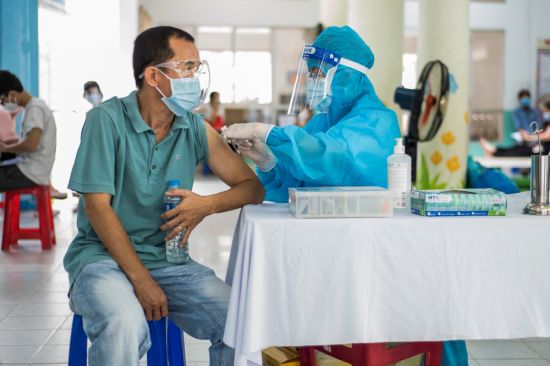Vietnam, Southeast Asia’s fifth biggest economy and third largest by population, has weathered the pandemic storm through a combination of strong yet flexible state leadership that won the confidence and trust of citizens, rapid and nimble response, and innovative use of technology, writes James Borton of the School of Advanced International Studies at Johns Hopkins University.
Electric vehicle battery plant in Haiphong, December 2021: With workers back in factories, Vietnam's economy is humming again: (Credit: NamLong Nguyen / Shutterstock.com)
The public health threat arrived like a raging storm moving fast across porous borders. In early 2020, Covid-19 broke out into a vulnerable world defined by division, mistrust and inequality. Few expected Vietnam, a single-party state with almost 100 million citizens and recognized as one of the youngest and fastest-growing economies in Southeast Asia, to surface as a successful model for pandemic preparedness and response. Across the border in China, Beijing’s ongoing “zero Covid” policy of containment through mass lockdowns, testing, isolation and intense surveillance stands in sharp contrast to Hanoi’s own lockdowns leavened by a willingness to adapt, lift restrictions and get the economy running again.
A 2022 study in The Lancet medical journal suggests that Vietnam should have stumbled in its battle against Covid-19. Instead, its government’s policies – and more important, the trust elicited from its citizens – have allowed the country to battle the virus effectively. The leadership of the Communist Part of Vietnam united in the war against the coronavirus, first with draconian travel measures to contain the transmission rate and then by launching a rapid vaccination program that administered 200 million doses. In addition, social media campaigns to alert citizens helped bolster the nation’s recovery to a current GDP growth rate of 2.91 percent, even as the pandemic has plunged many of the world’s economies into or near recession.
At the outset of the pandemic, Vietnam’s health authorities responded swiftly and then modified policies during the subsequent waves of infections. The nation’s prior experience during the severe acute respiratory syndrome (SARS) epidemic in 2003 and also the influx of avian and swine influenza cases between 2004 and 2010 meant that the country and its citizens were prepared to take the steps necessary to break the chain of infections. The government’s readiness for uncompromising rapid response was evident in the public health investments it had made in infrastructure, emergency operations centers and a national public health surveillance system. The knowledge built up from dealing with the previous epidemics accounted for the early development of serological monitoring that allowed assessment of disease transmission and immunity level. The establishment of a national serosurveillance bank provided strong support for the ambitious but costly vaccine program.
Even before the pandemic, the nation had in place an effective information and technology sector, coupled with high mobile phone penetration and social media use. The health crisis spurred more digital innovation including a government-led track-and-trace strategy. Assiduous contract tracing was highly effective. Healthcare workers could use Facebook and Instagram posts, as well as mobile-phone data, to identify individuals who had been in close proximity to people who tested positive. Scores of community volunteers gathered information through interviews.
Given the nature of the society and state authority, it was perhaps not surprising that Vietnamese did not object or question the deployment of an army of tracers, even though anyone identified as a close contact of a Covid-19 patient would face isolation in government quarantine facilities. The government, meanwhile, took advantage of the wide use of mobile phones in the country, releasing the PC-Covid Vietnam app that combined contact tracing with a vaccine pass function. This freed up contact tracers to focus on newly infected individuals who did not own a smartphone.
Another aspect of Vietnam’s Covid-19 response was the government’s crackdown on pandemic-related corruption. This has included criminal prosecutions for abuse of power relating to the distribution of coronavirus testing kits. A deputy foreign minister was arrested for allegedly receiving bribes in connection with the repatriation of Vietnamese stranded abroad. That the media were not impeded from reporting on these cases was surprising. By allowing instances of graft by officials to be made public, the government and the Communist Party gained the confidence and trust of citizens not just in their anti-Covid-19 efforts but also in their ongoing campaign against corruption that has resulted in the prosecution of thousands of party members.
The combination of an effective pandemic policy coupled with anti-corruption measures has spurred the economy towards expansion of 7 percent this year as risks from the coronavirus recede. That would measure up as one of the fastest paces of GDP growth in the region, outdistancing India’s projected 6.2 percent, according to the Asian Development Bank (ADB). To be sure, Vietnamese have gone through very tough times. But government social programs at different levels including innovations such as “rice ATMs” to dispense the staple grain and the “Ban Covid-19” operation to provide food and protective equipment to vulnerable citizens have helped to alleviate the hardship. Economists attribute Vietnam’s rapid recovery to stronger manufacturing performance as the workforce has returned to factories. Also helping Vietnam’s reopening to tourism. Covid-19 testing requirements for international arrivals have been abandoned.
Vietnam has also redoubled efforts to build trade and investment partnerships abroad. Hanoi is intent on strengthening not only its national security ties but also its economic relationship with the US. The US Agency for International Development (USAID) and Vietnam’s Ministry of Planning and Investment (MPI) recently organized a conference to outline plans and detail measures for enhancing the country’s business environment and national competitiveness in 2022, with particular emphasis on post-pandemic socio-economic recovery and development.
Vietnam’s reopening and its current trajectory towards robust economic recovery may be attributed to a strong sense of community and patriotism and to the fluid and flexible yet resolute government leadership in response to the enormous challenges that the global pandemic posed. This points to the country’s emergence as a strong economic and strategic player in the region, one of ASEAN’s leading member states and a much sought-after partner in the world of great power competition.
Further reading:
James Borton
Foreign Policy Institute, School of Advanced International Studies (SAIS), Johns Hopkins University
Check out here for more research and analysis from Asian perspectives.





